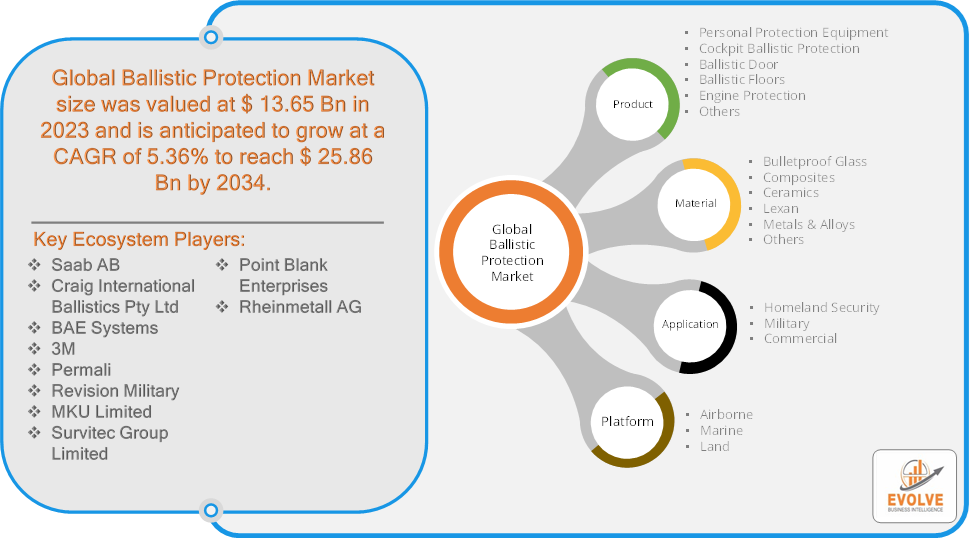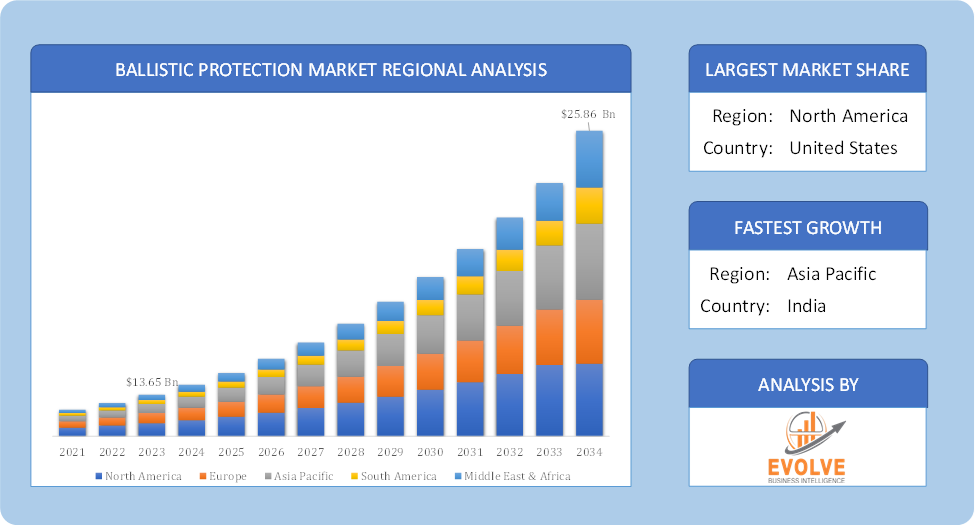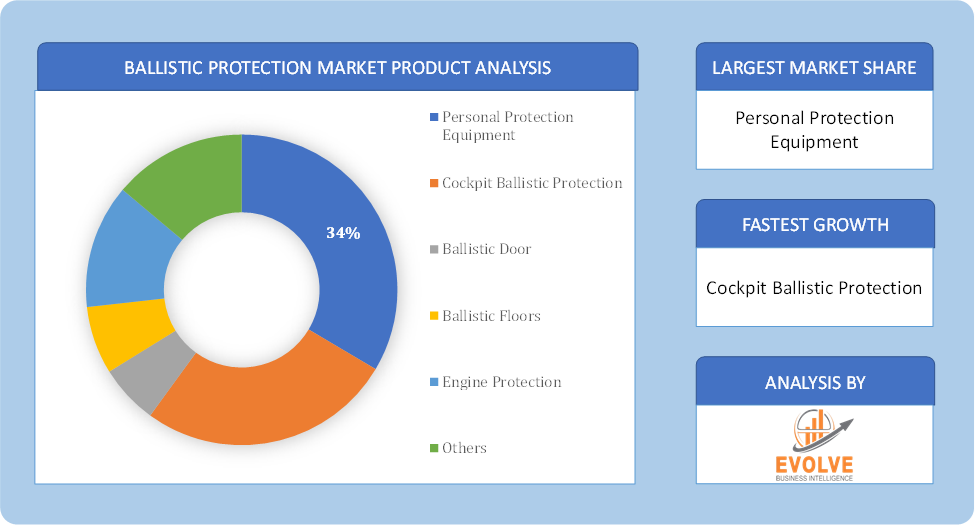Price range: $ 1,390.00 through $ 5,520.00
Ballistic Protection Market Research Report: Information By Product (Personal Protection Equipment, Cockpit Ballistic Protection, Ballistic Door, Ballistic Floors, Engine Protection, Others), By Material (Bulletproof Glass, Composites, Ceramics, Lexan, Metals & Alloys, Others), By Application (Homeland Security, Military, Commercial), By Platform (Airborne, Marine, Land), and by Region — Forecast till 2033
Page: 116
Description
Ballistic Protection Market Overview
The Ballistic Protection Market Size is expected to reach USD 607.2 Billion by 2033. The Ballistic Protection Market industry size accounted for USD 397.3 Billion in 2023 and is expected to expand at a compound annual growth rate (CAGR) of 4.41% from 2023 to 2033. The Ballistic Protection Market refers to the global industry focused on the development, manufacturing, and distribution of products and systems designed to protect individuals, vehicles, and structures from projectiles and explosive devices. This market encompasses a range of products, including body armor, helmets, bulletproof vests, ballistic shields, armored vehicles, and protective clothing. The primary customers for these products are military and defense forces, law enforcement agencies, and private security personnel, although there is also a growing demand from civilian sectors, particularly for personal protection.
The key drivers of the Ballistic Protection Market include increasing defense budgets, rising security concerns, advancements in material science (such as lightweight and more effective protective materials), and the growing need for safety and protection in conflict zones or areas prone to violence. The market is also influenced by stringent government regulations and standards regarding the quality and effectiveness of ballistic protection gear.
Global Ballistic Protection Market Synopsis
 Ballistic Protection Market Dynamics
Ballistic Protection Market Dynamics
The major factors that have impacted the growth of Ballistic Protection Market are as follows:
Drivers:
Ø Technological Advancements
Innovations in materials science, such as the development of lightweight yet highly durable materials like Kevlar, ultra-high-molecular-weight polyethylene (UHMWPE), and advanced ceramics, have improved the effectiveness and wearability of ballistic protection gear, fueling market growth. The growth of private security services, particularly in regions with high crime rates or unstable political environments, increases the demand for ballistic protection gear for security personnel.
Restraint:
- Perception of High Cost of Advanced Materials
The development of advanced ballistic protection solutions often involves the use of cutting-edge materials like Kevlar, aramid fibers, and advanced ceramics, which are expensive. The high cost of these materials can limit the affordability and widespread adoption of ballistic protection products, particularly in developing countries or among civilian users. Rapid advancements in weaponry, including more powerful firearms and new forms of projectiles, can quickly render existing ballistic protection solutions less effective, leading to the need for continuous research and development. This cycle of technological obsolescence can strain resources and increase costs for manufacturers.
Opportunity:
⮚ Integration of Smart Technologies
The integration of smart technologies, such as sensors, communication systems, and real-time data analytics, into ballistic protection gear offers a significant opportunity. These innovations could enhance the functionality of protective equipment by providing real-time threat detection, health monitoring, and situational awareness. There is an opportunity to develop and market ballistic protection products that are environmentally sustainable. Companies that can innovate in this space, using eco-friendly materials or reducing the carbon footprint of their production processes, could appeal to environmentally conscious buyers and meet emerging regulatory requirements.
Ballistic Protection Market Segment Overview
Based on Product, the market is segmented based on Personal Protection Equipment, Cockpit Ballistic Protection, Ballistic Door, Ballistic Floors, Engine Protection and Others. The Cockpit Ballistic Protection segment dominant the market. Cockpit ballistic protection is designed to protect the crew from direct fire and explosions, which is crucial in combat situations or high-risk environments. This protection is especially important for military aircraft operating in hostile territories or during missions where enemy fire is a significant threat.
By Material
Based on Material, the market has been divided into Bulletproof Glass, Composites, Ceramics, Lexan, Metals & Alloys and Others. The Bulletproof Glass segment dominant the market. Bulletproof glass is designed to protect individuals and assets by preventing penetration from bullets and other projectiles while maintaining visibility. It is widely used in vehicles, buildings, and secure facilities to protect against armed attacks.
By Application
Based on Application, the market has been divided into Homeland Security, Military and Commercial. The Homeland Security segment dominant the market. This is due to the segment’s provision of protection against specific ballistic threats, including personal protective equipment such as body vests, ballistic helmets, and gloves. These items are designed to safeguard the wearer against small arms fire and fragmentation threats during missions. The combat systems used by homeland security officers are reinforced with ceramics and thermoplastics to make them ballistic resistant.
By Platform
Based on Platform, the market has been divided into Airborne, Marine and Land. The airborne segment is dominant due to the increasing demand for aircraft across various aviation platforms for military purposes, changes in the dynamics of war, and the prominent use of UAVs on the battlefield.
Global Ballistic Protection Market Regional Analysis
Based on region, the global Ballistic Protection Market has been divided into North America, Europe, Asia-Pacific, the Middle East & Africa, and Latin America. North America is projected to dominate the use of the Ballistic Protection Market followed by the Asia-Pacific and Europe regions.
 Ballistic Protection North America Market
Ballistic Protection North America Market
North America holds a dominant position in the Ballistic Protection Market. North America, particularly the United States, is one of the largest markets for ballistic protection. This region has significant defense spending and a strong emphasis on national security, driving demand for advanced ballistic protection solutions for military, law enforcement, and private security and growing demand for advanced, lightweight, and customizable protection gear, particularly in response to evolving security threats and the need for better protection of law enforcement officers.
Ballistic Protection Asia-Pacific Market
The Asia-Pacific region has indeed emerged as the fastest-growing market for the Ballistic Protection Market industry. The Asia-Pacific region is experiencing rapid growth in the ballistic protection market, driven by increasing defense spending, regional conflicts, and the modernization of military forces in countries like China, India, Japan, and South Korea and significant potential for market expansion due to the increasing need for ballistic protection in military and law enforcement, as well as emerging demand in the civilian sector, particularly in urbanized and high-risk areas.
Competitive Landscape
The global Ballistic Protection Market is highly competitive, with numerous players offering a wide range of software solutions. The competitive landscape is characterized by the presence of established companies, as well as emerging startups and niche players. To increase their market position and attract a wide consumer base, the businesses are employing various strategies, such as product launches, and strategic alliances.
Prominent Players:
- Saab AB
- Craig International Ballistics Pty Ltd
- BAE Systems
- 3M
- Permali
- Revision Military
- MKU Limited
- Survitec Group Limited
- Point Blank Enterprises
- Rheinmetall AG.
Key Development
In May 2024, Craig International Ballistics announced that they would supply ballistic protection windows for the first three Hunter-class frigates under an agreement with BAE Systems Maritime Australia.
In October 2023, Dyneema, part of Avient Corporation, launched a next-generation UD material based on its third-generation fiber, Dyneema. This is expected to enable 10–20% lighter soft armor vests.
Scope of the Report
Global Ballistic Protection Market, by Product
- Personal Protection Equipment
- Cockpit Ballistic Protection
- Ballistic Door
- Ballistic Floors
- Engine Protection
- Others
Global Ballistic Protection Market, by Material
- Bulletproof Glass
- Composites
- Ceramics
- Lexan
- Metals & Alloys
- Others
- Global Ballistic Protection Market, by Application
- Homeland Security
- Military
- Commercial
Global Ballistic Protection Market, by Platform
- Airborne
- Marine
- Land
Global Ballistic Protection Market, by Region
- North America
- US
- Canada
- Mexico
- Europe
- UK
- Germany
- France
- Italy
- Spain
- Benelux
- Nordic
- Rest of Europe
- Asia Pacific
- China
- Japan
- South Korea
- Indonesia
- Austalia
- Malaysia
- India
- Rest of Asia Pacific
- South America
- Brazil
- Argentina
- Rest of South America
- Middle East & Africa
- Saudi Arabia
- UAE
- Egypt
- South Africa
- Rest of Middle East & Africa
| Parameters | Indicators |
|---|---|
| Market Size | 2033: USD 607.2 Billion |
| CAGR (2023-2033) | 4.41% |
| Base year | 2022 |
| Forecast Period | 2023-2033 |
| Historical Data | 2021 (2017 to 2020 On Demand) |
| Report Coverage | Revenue Forecast, Competitive Landscape, Growth Factors, and Trends |
| Key Segmentations | Product, Material, Application, Platform |
| Geographies Covered | North America, Europe, Asia-Pacific, South America, Middle East, Africa |
| Key Vendors | Saab AB, Craig International Ballistics Pty Ltd, BAE Systems, 3M, Permali, Revision Military, MKU Limited, Survitec Group Limited, Point Blank Enterprises and Rheinmetall AG. |
| Key Market Opportunities | · Integration of Smart Technologies
· Sustainable and Environmentally Friendly Products |
| Key Market Drivers | · Technological Advancements
· Expansion of the Private Security Sector |
REPORT CONTENT BRIEF:
- High-level analysis of the current and future Ballistic Protection Market trends and opportunities
- Detailed analysis of current market drivers, restraining factors, and opportunities in the future
- Ballistic Protection Market historical market size for the year 2021, and forecast from 2023 to 2033
- Ballistic Protection Market share analysis at each product level
- Competitor analysis with detailed insight into its product segment, Government & Defense strength, and strategies adopted.
- Identifies key strategies adopted including product launches and developments, mergers and acquisitions, joint ventures, collaborations, and partnerships as well as funding taken and investment done, among others.
- To identify and understand the various factors involved in the global Ballistic Protection Market affected by the pandemic
- To provide a detailed insight into the major companies operating in the market. The profiling will include the Government & Defense health of the company’s past 2-3 years with segmental and regional revenue breakup, product offering, recent developments, SWOT analysis, and key strategies.
Frequently Asked Questions (FAQ)
What is the growth rate of the global Ballistic Protection Market?
The global Ballistic Protection Market is growing at a CAGR of 4.41% over the next 10 years
Which region has the highest growth rate in the market of Ballistic Protection Market?
Asia Pacific is expected to register the highest CAGR during 2023-2033
Which region has the largest share of the global Ballistic Protection Market?
North America holds the largest share in 2022
Who are the key players in the global Ballistic Protection Market?
Saab AB, Craig International Ballistics Pty Ltd, BAE Systems, 3M, Permali, Revision Military, MKU Limited, Survitec Group Limited, Point Blank Enterprises and Rheinmetall AG. are the major companies operating in the market.
Do you offer Post Sale Support?
Yes, we offer 16 hours of analyst support to solve the queries
Do you sell particular sections of a report?
Yes, we provide regional as well as country-level reports. Other than this we also provide a sectional report. Please get in contact with our sales representatives.
Additional information
| Packages | Single User License, Enterprise License, Data Pack Excel |
|---|
Table of Content
[html_block id="8298"]

